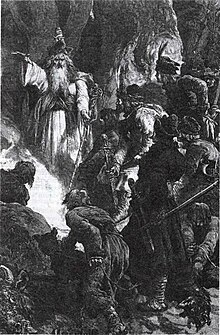Lizdeika

Lizdeika was a semi-legendary pagan priest (krivis) in 14th-century Grand Duchy of Lithuania. He is associated with the legend of founding of Vilnius recorded in the 16th-century Lithuanian Chronicles.[1] The legend was popularized by 19th-century romantic nationalism.
Legends
[edit]
According to the legend first recorded in the Bychowiec Chronicle, Grand Duke of Lithuania Gediminas went hunting in the Šventaragis' Valley, fell asleep, and dreamed of a huge howling Iron Wolf. Lizdeika interpreted the dream to mean that a city, which would become the Lithuanian capital, should be founded at the location.[2] The legend probably originated in the early 16th century. Somewhat resembling the legend of Romulus and Remus, it probably reflects the contemporary fashionable theories among the Lithuanian nobility about their Latin origin.[3]
The chronicle also mentioned that Lizdeika was the chief pagan priest (Kriwe Kriwaito) and that he was found in an eagle's nest (Lithuanian lizdas means nest). Maciej Stryjkowski added additional note that Lizdeika was found in an eagle's nest or, according to others, in a cradle in a tree by Grand Duke Vytenis who raised him as his son.[4] Various 19th-century authors, including Adam Kirkor and Michal Baliński, claimed that Lizdeika was found in Verkiai, a suburb of Vilnius.[5] Researchers of the Lithuanian mythology, including Vladimir Toporov and Gintaras Beresnevičius, analyzed Lizdeika's origin and noted its shamanistic motifs.[6][7]
Albert Wijuk Kojałowicz (1609–1677) in his armorial of the Grand Duchy of Lithuania and work about the Radziwiłł family identified Lizdeika as its progenitor. While this genealogy became popular in later centuries, there is no evidence to support it and it is discarded by modern historians.[8]
Cultural references
[edit]- Lizdeika is a character in the 1826 novel Pojata córka Lezdejki albo Litwini w XIV wieku (Pajauta, Lizdeika's Daughter, or Lithuanians in the 14th Century) by Feliks Bernatowicz. Due to the popularity of the novel, one of the Kernavė Mounds is known as the Lizdeika Mound.[9]
- Lizdeika is a character in the 1906 Lithuanian opera Birutė.
References
[edit]- ^ Narbutas, Ignas (9 April 2021) [2018]. "Lizdeika". Visuotinė lietuvių enciklopedija (in Lithuanian). Mokslo ir enciklopedijų leidybos centras. Retrieved 21 June 2023.
- ^ "The Legend of the Founding of Vilnius"
- ^ Sužiedėlis, Saulius (2011). Historical Dictionary of Lithuania. Historical dictionaries of Europe. Vol. 80. Scarecrow Press. p. 136. ISBN 978-0-8108-4914-3.
- ^ Norbertas, Vėlius, ed. (2001). Baltų religijos ir mitologijos šaltiniai (in Lithuanian). Vol. 2: XVI amžius. Mokslo ir enciklopedijų leidybos institutas. pp. 382, 555. ISBN 5-420-01486-6.
- ^ Janonienė, Rūta (2002). "Lietuvos istorijos fragmentai Verkių peizažuose". Menotyra (in Lithuanian). 2 (27): 37.
- ^ Bojtár, Endre (1999). Foreword to the Past: A Cultural History of the Baltic People. CEU Press. p. 329. ISBN 963-9116-42-4.
- ^ Razauskas, Dainius (2017). "Lizdeikos gija lietuvių dvasinėje tradicijoje" (PDF). Liaudies kultūra (in Lithuanian). 1: 30. ISSN 0236-0551.
- ^ Antanavičius, Darius (2004). "Radvilų kunigaikštiškos kilmės teorijos genezė Alberto Vijūko Kojalavičiaus genealoginiuose darbuose". In Rimša, Edmundas (ed.). Istorijos akiračiai (in Lithuanian). Vilnius: Lietuvos istorijos instituto leidykla. pp. 235–240. ISBN 9986780632.
- ^ Poškienė, Justina (2018). "Lithuanian Troy: Preservation and Interpretation of Kernavė, a UNESCO World Heritage Archaeological Site". Analecta Archaeologica Ressoviensia. 13: 471. doi:10.15584/anarres.2018.13.22.
